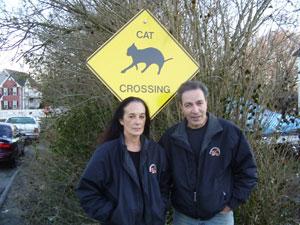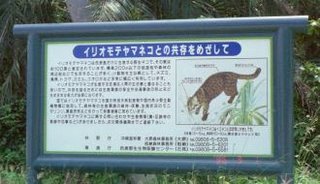Cat Activists Succeed in Getting a Connecticut Town to Erect a Cat Crossing Sign

"Everyone tends to turn their backs on cats, but the sign makes them more aware of their presence. A lot of people have been more cautious when driving down the street."
-- Milford resident Jessica Leto
Dans le Paris, a pedestrian is defined as viande a pneus and conditions are not much safer in America. The individual behind the wheel with his foot on the accelerator, whether he be a homicidal maniac, a drunk, or a commuter in a hurry, is the undisputed king of the road and woe to anyone, man or animal, who gets in his way.
Not only are travelers on foot placing their lives in jeopardy by attempting to cross the street, but they are not even safe on either footpaths or grassy shoulders. Speed restrictions are seldom observed and most motorists mistakenly believe that a red light means "stop wasting time."
This deplorable situation is exacerbated by the law enforcement community's steadfast refusal to enforce the laws of the road; the cops only show up after a fatality and then it is merely to provide escort service for the body-collectors. In New Jersey, for instance, pedestrian safety is pretty much limited to fatuous public service announcements by feckless politicians who seem to feel that anyone crazy enough to be traveling a pied deserves whatever he gets.
Statistics lend credence to this dire assessment. In the United States, more than five-thousand pedestrians are struck and killed each year and another seventy-thousand are injured. The numbers for Europe are comparable.
If the roads are this lethal for walkers, they are a thousand times more deadly for animals. More to the point, it is estimated that several million animals die underneath the wheels of the motoring public each year in the United States. Their ensanguinated and mangled corpses are a memento mori of man's unstinting cruelty toward them.
Compounding matters further, some drivers make a game out of killing animals and this observation is verified by the fact that fleet-of-foot animals such as cats, squirrels, and birds are not easily run down. Besides, all vehicles on the road today are equipped with power steering and brakes as well as advanced suspension systems; even tour buses can be stopped on a dime on a dry track.

Although pedestrian, school, and railroad crossing signs have long been ubiquitous, those erected to protect animals have been pretty much restricted to deer; worse still, even these warnings are geared more toward the protection of motorists than deer. This callous indifference to the lives of animals could be about to change, however, and Milford, Connecticut is leading the way.
Thanks to the persistent lobbying efforts of cat-lovers Bobette Moore and Gary Caufield (See photo above), a big yellow cat crossing sign has been erected on Erna Avenue. The duo, who regularly feed and shelter feral cats in the neighborhood, were prompted to act after a number of defenseless felines were run down and killed while attempting to cross the street.
Public Works Director Bruce Kolwicz, whose department constructed and erected the sign, told the Connecticut Post on January 18th, "It appears to have made a big difference. It's not really enforceable, but it's working and that's what really matters." (See "Cat Crossing Sign May Save Lives.")
After pointing out that the city, fourteen kilometers south of New Haven, already has duck crossing signs at ponds near City Hall, Kolwicz added, "It's just something to give people a heads-up when traveling through the street."
City resident Jessica Leto concurs. "Everyone tends to turn their backs on cats, but the sign makes them more aware of their presence," she told the Connecticut Post. "A lot of people have been more cautious when driving down the street."
The sign has also drawn praise from Animal Control Officer Pat Liptak. "It's a wonderful law," she exclaimed to the Connecticut Post. "I'm glad they realized there was a need and did what they could to help. There are probably twenty other places in the city where we could use the signs. Cats are getting killed all the time but Erna Avenue was one of the worst spots."

She is right, of course. Milford does need additional cat crossing signs and, moreover, the city should criminalize the failure to yield to cats and all other animals. Their lives are no less precious than those of humans and by learning to watch out for them motorists may one day learn to be more respectful of pedestrians.
Although it is not clear if Milford's cat crossing sign is the first of its kind in the nation, the only other known examples of such signs are on the remote Japanese island of Iriomote. (See photos above.) Officials there are waging a valiant struggle to save the endangered Iriomote Wildcat from both motorists and developers. (See Cat Defender post of November 27, 2006 entitled "After Surviving on Its Own for at Least Two-Million Years, Rare Japanese Wildcat Faces Toughest Battle Yet.")
Whether the address is Iriomote, Milford, or elsewhere, the time has clearly come for both laws and road signs that protect cats and other animals from the homicidal urges of motorists.
Photos: Connecticut Post (cat crossing sign) and Kanpira (Iriomote signs.)

<< Home